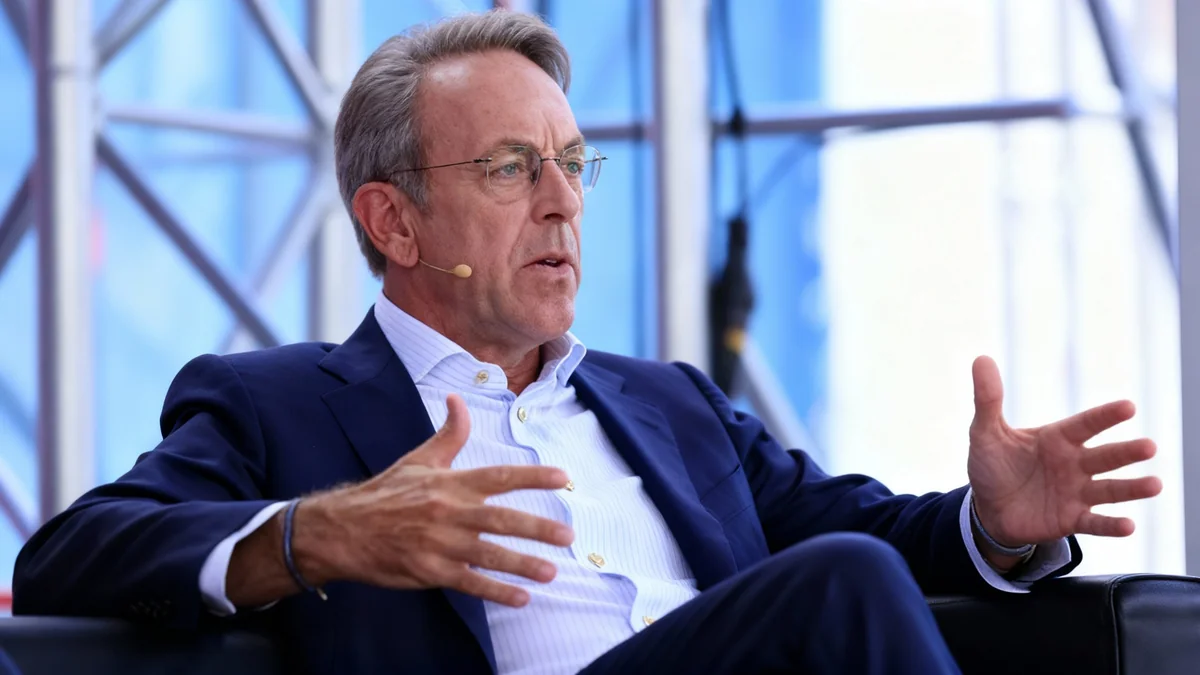Global financial markets are experiencing a significant surge, largely driven by investor enthusiasm for artificial intelligence. Major indices like the S&P 500 and Nasdaq have reached new record highs, with technology companies such as Nvidia at the forefront of the rally. This momentum continues even as investors process new information from the Federal Reserve and monitor ongoing geopolitical developments.
Despite warnings from central banks about potentially inflated valuations in the AI sector, the market's focus remains fixed on the transformative potential of this technology. Meanwhile, other significant events, including Federal Reserve meeting minutes hinting at future interest rate cuts and shifts in corporate remote work policies, are also shaping the economic landscape.
Key Takeaways
- Artificial intelligence stocks, particularly Nvidia, are the primary drivers behind recent record highs in the S&P 500 and Nasdaq indices.
- The Bank of England has issued a warning that valuations for AI-related companies may be "stretched," posing a potential risk to equity markets.
- Federal Reserve minutes from September indicate officials were leaning towards interest rate cuts, with projections suggesting two cuts by the end of 2025.
- Google is tightening its remote work policies, signaling a broader corporate trend of encouraging employees to return to the office.
- Commodity markets are also active, with some analysts projecting gold could reach as high as $5,000 per ounce by 2026.
AI Dominates Market Narrative
The current story of the stock market is overwhelmingly centered on artificial intelligence. While traditional economic indicators and government activities, such as the U.S. shutdown and Federal Reserve discussions, typically hold investor attention, they have been overshadowed by the excitement surrounding AI.
Companies at the heart of the AI revolution are seeing their market capitalizations soar. Nvidia, a leading designer of AI chips, has become a market bellwether, with its performance heavily influencing broader market trends. The S&P 500 and Nasdaq both achieved new all-time intraday and closing highs on Wednesday, a rally primarily powered by the information technology sector.
However, the influence of tech giants is not uniformly positive. A recent dip in Oracle's stock was cited as a key factor in ending a seven-day winning streak for the S&P 500, demonstrating how the performance of a single major tech firm can sway the entire market.
Valuation Concerns Emerge
With rapid gains come increased scrutiny. The Bank of England recently cautioned that valuations in the equity market appear "stretched," with a specific focus on companies involved in artificial intelligence. The central bank warned that markets could face a significant correction if the high expectations for AI's impact are not met.
Market Performance Snapshot
On Wednesday, the S&P 500 and Nasdaq both set new record highs. The rally was broad-based but led by the information technology, utilities, and industrial sectors, underscoring the widespread optimism in the market.
This raises a critical question for investors: is the current AI-fueled rally built on a solid foundation of innovation and future earnings, or is it a speculative bubble at risk of bursting? For now, the prevailing sentiment on Wall Street remains highly optimistic, driven by the dual hopes of technological breakthroughs and supportive monetary policy from the Federal Reserve.
Federal Reserve Signals Future Rate Cuts
While AI has captured the headlines, monetary policy remains a crucial background factor for the markets. Recently released minutes from the Federal Reserve's September meeting provided insight into the central bank's thinking, revealing a strong inclination among officials to lower interest rates in the near future.
The primary point of discussion among Fed officials was not whether to cut rates, but rather the timing and number of cuts. Projections from the meeting suggest a consensus forming around two interest rate reductions by the end of 2025. This dovish stance has provided additional fuel for the stock market rally, as lower borrowing costs are generally beneficial for corporate profits and stock valuations.
Why Interest Rates Matter
Central bank interest rates influence the cost of borrowing for businesses and consumers. Lower rates can stimulate economic activity by making it cheaper for companies to invest and for individuals to take out loans for major purchases. For the stock market, lower rates can make equities more attractive compared to bonds and other fixed-income investments.
Investors are closely watching for any further signals from the Fed, as the path of interest rates will be a key determinant of market performance throughout the coming year. The prospect of rate cuts helps to counterbalance some of the concerns about high stock valuations.
Corporate and Geopolitical Developments
Beyond the primary market drivers, other events are shaping the global landscape. In the corporate world, Google is implementing new restrictions on its "Work from Anywhere" policy, which was introduced during the pandemic. According to internal documents, the policy that allowed employees to work from a different location for four weeks per year is being significantly tightened.
Google's Shifting Remote Work Policy
The changes at Google reflect a broader trend among large corporations to bring employees back to the office more regularly. The pandemic-era flexibility is gradually being replaced by more structured hybrid or in-office mandates. This shift has implications for commercial real estate, urban economies, and the future of work itself.
On the geopolitical front, U.S. President Donald Trump announced that a "first phase" plan had been agreed upon by Israel and Hamas. According to the statement, this initial stage would involve the release of all hostages and an Israeli withdrawal of forces to an agreed-upon line. Such developments are monitored by markets for their potential impact on global stability and energy prices.
Competition and Commentary in the AI Sector
The competitive dynamics within the AI industry continue to generate news. A multi-billion dollar partnership between Advanced Micro Devices (AMD) and OpenAI has drawn public comment from a key industry leader.
Nvidia CEO Jensen Huang expressed surprise at the terms of the deal, in which AMD reportedly offered 10% of itself to OpenAI. In a public statement, Huang commented on the arrangement.
"I’m surprised that they would give away 10% of the company before they even built it. And so anyhow, it’s clever, I guess," Huang said on Wednesday.
This commentary highlights the high-stakes competition among semiconductor firms to secure partnerships with leading AI research labs. The structure of these deals can have significant long-term implications for the companies involved and the broader technology ecosystem.
Other Market Movements
While technology stocks have been dominant, other asset classes are also seeing notable activity. The price of gold has reached new highs, prompting discussion among analysts about its future potential. Some industry experts believe the precious metal has further room to grow, with one analyst suggesting a possible price of $5,000 per ounce by 2026. This reflects ongoing investor demand for safe-haven assets amid economic uncertainty.
In Europe, stock markets also ended higher, partly in response to a proposal from the European Union to reduce its tariff-free steel import quota. This move could benefit domestic steel producers and has been received positively by investors in the industrial sector.





